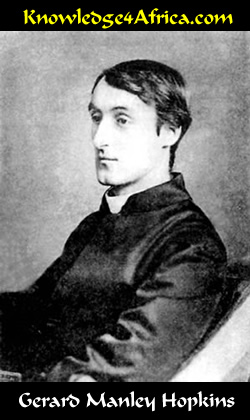|
READ THIS
A falcon catches the poet's eye as it rides the air at dawn.
The poet, however, is then given to reflect on his Lord, Jesus Christ. The falcon becomes the image of
a knight upon his horse, and of Jesus as he carries his cross and is crucified upon the hill outside
Jerusalem.
 INSCAPE & INSTRESS
INSCAPE & INSTRESS
At the heart of understanding Hopkins' poetry are two fundamental principles which the poet called
inscape and instress.
Hopkins, in his search for an aesthetic understanding of nature, found value in the writings of the great
medieval theologian-philosopher, Duns Scotus, who attempted to distinguish the difference between the
individual and the species.
What makes Peter different from other men? What makes Angela different from other girls? What
makes my cat different from other cats?
Duns Scotus claimed that Peter and Angela each have an essence, a "this-ness", which is what
marks them apart from others.
My cat too has a "this-ness".
Hopkins would expand on the concept of "this-ness" and call it inscape.
Inscape then is that unique property in things which makes them distinctive. It is the inner essence
of the thing.
This uniqueness represents the beauty of the thing. Even more: it represents the beauty of God that is
reflected in the thing.
When the poet looks into the sky in the morning and sees a falcon floating on the wind, he sees more than
just a bird. He sees the inner beauty of the bird.
But within this inner beauty, he also sees the beauty that is God. The falcon's inscape is therefore
the beautifying principle of God himself.
Not everybody, however, can see this inscape, this inner manifestation of beauty and the presence
of God. Only the true artist can see it.
And Hopkins gave the name instress to this ability to witness the inscape in something.
Instress is therefore the feeling that one has for the inner quality in something. This is what
characterises the artist.
Instress is the mystical ability that enables the artist to perceive the inner beautifying
principle or inscape.
Instress is the sensation of inscape, where the artist becomes aware of the
inscape of the thing of beauty.
Most living people, Hopkins said, are fundamentally dead to this world of inscape, i.e. most people
just cannot see this inner beauty in something else.
Artistic creation, on the other hand, happens when the artist becomes instressed with the personal
inscape of the other.
The work of art that then follows -- e.g. a poem or painting -- is what Hopkins called a new
inscape.
The poem or painting thereupon has its own inscape -- i.e. it too becomes a thing of beauty which
reflects the beauty of God.
When the reader's inscape becomes aware of the beauty of the poem, then the reader has become
instressed.
But once again, not everybody has this ability. The kid in the classroom who bleats, "Ma'am, why do
we have to do poetry?" says this because he lacks instress.
He's the type of being who looks at the sunset and is reminded of a fried egg, soft side up.
Have you looked at the questions
in the right column?
|
TEST YOURSELF!
Read the left column and then answer
the following questions:
Hopkins is known for creating words. Work out the possible meaning of the following two words:

[Need help?]
Because "wimpling wing" is a created word, the poet leaves you, the reader, scope to place your
own meaning to the word.
A "wimple" is a silk headdress covering the neck and the sides of the face, formerly worn by
women. Is the poet therefore using the word "wimpling" to describe the shiny neck feathers of the
bird?
The poet, however, is also creating the image of a "chevalier" -- a knight -- riding his horse.
Is the word "wimpling" then not also an attempt to convey the hesitant gait of a horse that is being
controlled by the knight?
|

[Need help?]
The poet says that "sillion" shines. Is it therefore something that is silver and shiny, like foil? In
another sonnet, Hopkins speaks about "shook foil".
The word "sillion" also rhymes with "billion", which was in Hopkins' day an intangible number.
Is the poet therefore attempting to convey this intangibility to "sillion" as well?
|
Brute beauty and valour and act, oh, air, pride, plume, here
Buckle! AND the fire that breaks from thee then, a billion
Times told lovelier, more dangerous, O my chevalier!
- Comment on the alliteration in "Brute beauty". (4)

[Need help?]
There's a harshness to the alliterated B's, is there not? It's a forceful sound, denoting great strength.
Notice too that the alliteration will continue with the words "buckle" and "billion", to create
words of untold strength and power.
|
- What is "the fire that breaks from thee"? (4)

[Need help?]
At a superficial level, the fire is probably the glint of sunlight that reflects from the falcon's feathers. It
"breaks" from the bird because the poet sees flashes of light.
The beauty of the bird is also a reflection of the beauty of God. Indeed, the sonnet is introduced with the
words "To Christ our Lord" which gives us a clue that the poet is in fact not just contemplating the
bird but is also contemplating Jesus Christ, his Lord.
So the bird therefore represents Jesus Christ. Once this step has been made, the meaning of the word
"fire" becomes astonishing: the fire of love that shines through Christ, the fire of salvation, etc.
The fire "breaks" from Christ too. Jesus was a broken man at his crucifixion, but his breaking
released the fire of salvation.
|
- Why should this fire be "a billion times told lovelier, more dangerous"? (4)

[Need help?]
For the poet, then, this fire is literally "a billion times told lovelier" because it brings salvation, but
"more dangerous" because it represents the fire of the wrath of God.
|
- What is a "chevalier"? (2)

[Need help?]
A "chevalier" is a medieval knight.
|
- Why does the poet address the falcon as "O my chevalier!"? (6)

[Need help?]
At a superficial level, the "chevalier" refers to the falcon. The address "O my chevalier!"
would be the polite way of addressing an important being.
The falcon, as God's messenger to the poet, is such an important being and therefore deserving of being
addressed properly. (The poet T.S. Eliot says that, when you address your cat, you must say, "O
Cat!")
There is another level of meaning though.
The "chevalier" is a young knight in the service of the king. It seems clear that Hopkins perceives
the knight as Jesus Christ who is in the service of his king, namely God the Father.
As such, the poet is Christ's servant and therefore must afford all due honour to the knight, his Lord, by
addressing him as "O my chevalier!".
|
Having understood the concept of "inscape" and "instress" -- read the notes in the left
column -- explain to what extent "inscape" is important in understanding the poet's vision of the
falcon in this sonnet. (10)

[Need help?]
Hopkins believed it important to see the inner nature of beauty which is the reflection of God.
Although we cannot see God, we can perceive him through his reflection in nature and through the beauty
that is all around us.
And so the poet developed the concept "inscape" to capture that beauty of God that is the inner-
principle in all beauty.
The poet sees the falcon at dawn. He is staggered by its beauty. But the beauty of the bird is a reflection
of the beauty of God -- "inscape".
The poet then reflects on the deeper meaning of this beauty, and so contemplates the person of Jesus
Christ which is reflected in the falcon.
The poem then is much more than just a contemplation of the falcon. It is a contemplation of Jesus
Christ, his crucifixion and salvation.
This is the most complex piece of poetic writing you are likely to read.
|
An image is a concealed picture which the poet has hidden within his words but which he wishes the
astute reader to see. In this sonnet, two images are hidden away. What are they? Here are the clues
for each:
- Minion, kingdom, chevalier, riding, striding, rein, pride, plume. (4)

[Need help?]
The key here is the word "chevalier" or knight. The rest of the words are all connected with the
knight.
"Minion" is a medieval term referring to knighthood. The knight is a minion or favourite servant of
the king. The knight himself has minions or servants of his own.
The knight "rides" a horse, "striding" into battle, holding firmly to the "reins".
As part of his accoutrement, he wears a suit of armour with a "plume" on his helmet.
And so the knight is definitely one of the images used. Through the picture of the falcon gliding on the
wind one sees a deeper picture -- hidden in the words -- of the knight on his horse.
Even the rhythm of the first three lines of the sonnet is that of the easy sway of the knight on his horse.
|
- Kingdom, dauphin, plod, plough, brute, buckle, fall, gall, breaks, gash, blue, gold-
vermillion. (4)

[Need help?]
The "dauphin" is the eldest son of the king. And so the image is that of the son of a king. But what
type of son? What type of king?
What son of the king "plods", "buckles" under the weight of a heavy load which he is
dragging behind him, which weight "ploughs" the ground behind him as he struggles with it?
And then he "falls", he hurts himself. He is whipped, broken. He bleeds "vermillion"
coloured blood. He is offered "gall" to drink.
The common link is surely Jesus Christ. Hopkins is referring to the image of Christ the King.
Jesus Christ is royal -- his blood is "blue".
But he bleeds "gold-vermillion" when crucified. Gold represents holiness. But blood is also red
--
and "vermillion" is a deep royal shade of red.
And so the poet's contemplation of the falcon leads him to contemplate the death of Christ, his Lord, to
whom the poem is then dedicated.
|
|



